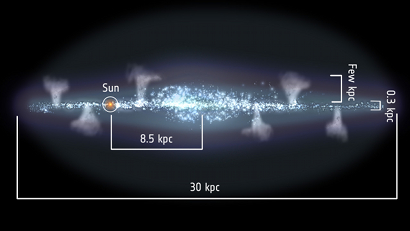Recycling is good, but sometimes it needs a little help from outside.

ESA / Gaia / DPAC; CC BY-SA 3.0 IGO. Acknowledgement: A. Moitinho.
Our Milky Way is a huge cosmic recycling machine. Stellar winds and supernova explosions spew material out into space, well above and below our galaxy’s central plane. But just like water in a fountain, these tenuous clouds fall back again, thanks to the gravitational pull of the galactic disk. Eventually, the gas and dust in those clouds condense into new stars, and the recycling is complete.
Two Japanese astronomers now claim that the infalling clouds also contain lots of extragalactic material, indicating that raw materials from outside are adding to the recycling fountain. However, precise details of the process are still elusive. According to radio astronomer Jay Lockman (NRAO), “The new work is interesting, and certainly adds to our understanding of the Milky Way and its environment, but it is unlikely to be the complete picture.”

ESA
In the 1960s, radio astronomers discovered clouds of neutral hydrogen at thousands of light-years above and below the galactic disk, moving toward or (sometimes) away from us at tens of kilometers per second. There appear to be two populations of these clouds: high-velocity clouds (HVCs, with velocities more than 100 km/s, or 200,000 mph) are usually farther away, while the slower intermediate-velocity clouds (IVCs) are located closer to the galactic plane.
To study the composition of the both sets of clouds, Takahiro Hayakawa and Yasuo Fukui (both at Nagoya University, Japan) compared existing radio data from the Effelsberg and Parkes radio telescopes (in Germany and Australia, respectively) with submillimeter measurements of the European Space Agency’s Planck mission.
The 21-cm-wavelength radio data reveal the amount (and velocity toward or away) of the neutral hydrogen gas in the clouds. Meanwhile, the Planck data indicate the abundance of tiny, solid dust particles in the clouds — a proxy for the abundance of heavy elements, or metallicity.
In high-velocity clouds, their low metallicity suggests an extragalactic origin, consistent with earlier estimates based on different and less precise techniques. But in the 20-year-old “galactic fountain” theory, IVCs should mainly consist of material from stellar winds and supernova explosions. If so, they should be enriched with the heavy elements produced by the nuclear fusion that takes place in the interiors of stars.
However, the new results show that many IVCs are instead relatively dust-poor, suggesting fewer heavy elements than expected. Apparently, the researchers claim, they contain substantial amounts of pristine extragalactic gas. The results are published in the Monthly Notices of the Royal Astronomical Society.

T. Hayakawa / Y. Fukui (Nagoya University)
In fact, the fraction of gas coming from outside our galaxy might even be higher than the new measurements indicate: According to Hayakawa and Fukui, relatively pristine clouds would interact with the higher-metallicity gas in the Milky Way’s halo, and slowing down and becoming “contaminated” as a result.
However, Lockman stresses that the new work “by no means negates the existence of a galactic fountain and its products.” Some IVCs have a significant metallicity, with a chemistry (including molecules like hydroxyl) that’s similar to clouds in our galaxy’s disk, he says. “These IVCs could quite well be the products of a galactic fountain.”
Moreover, it’s not impossible that some IVCs are really HVCs in disguise. “We can only measure one component of an object’s 3D motion,” says Lockman, “and there may be a population of ‘low-velocity HVCs’ that have a low radial velocity simply because of projection effects.”
Some sixty years after they were first discovered and described, the high- and intermediate-velocity clouds of hydrogen surrounding the galactic disk are still reluctant to give up all their secrets. The hope is that future facilities like the Square Kilometre Array (SKA) and the planned next-generation Very Large Array (ngVLA) will finally reveal the ecology, sustainability, and recycling capacity of our Milky Way galaxy.
 1
1









Comments
Martian-Bachelor
April 1, 2024 at 12:15 am
The sub-mm observations pick up the thermal emission from dust grains approximately that size and larger. If the heavier elements (metals) remain in the gas phase as individual atoms or ions rather than form grains they wouldn't show up at sub-mm wavelengths.
The best evidence for a fountain or chimney effect of some kind in the disks of spiral galaxies comes from something noticed and strongly stressed by Sydney van den Bergh about three decades ago. Before there were systematic searches for SN, they were found largely serendipitously. Van den Bergh noticed that a large percentage discovered this way were in galaxies that were nearly face-on, say at an inclination of less than 30-35 degrees to being pole-on. Such galaxies are statistically rarer than their more edge-on counterparts, but they accounted for a large proportion of SN discoveries. The implication was that we needed galaxies to be more nearly face-on to be able to see down the chimneys evacuated and formed by previous SN, in order to be able to see current SN, rather than have them obscured by dust. What happens to this material blown out of the disk then is still the current uncertainty.
You must be logged in to post a comment.
You must be logged in to post a comment.